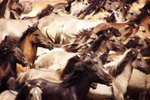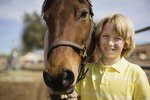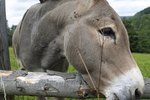Donkeys, also known as asses or burros, have long been companion and work animals for humans. Archaeologists found several nearly complete donkey skeletons that had been carefully buried in Egyptian tombs dating to more than 5,000 years ago, suggesting domestication at that time. Today, donkeys serve in transport and agricultural work, and as companion animals.
Physical Characteristics
As members of the Equidae family, donkeys closely resemble horses and zebras. However, donkeys' specific physical characteristics that set them apart from their close relatives.
Donkeys tend to be smaller than horses, although some donkeys are larger than some ponies. One of the biggest differences in donkeys and horses is ear size: Donkey ears are typically much longer than those of horses. Donkey manes are stiff and upright, while those of horses are more hairlike: not upright, but long and flowing. Tails are also different: Donkey tails are covered with short hair until the end, which ends with a brush of longer hair; horse tails consist of long, flowing hair from the base of the rump -- the common human "ponytail" is very similar to the tail of a horse or pony.
Most donkeys have a smooth coat in varying shades of gray or fawn; however, some breeds have different coats, such as the Poitou, which has a dark, shaggy coat.
Size Variations
Donkeys are often labeled by their sizes, which range from less than 3 feet tall to over 14 hands. A hand, a unit of measurement equaling 4 inches, commonly serves to measure the height of horses and other equines from the ground to the highest point of the shoulders, also called the withers.
Size classifications include miniature, standard, large standard and mammoth stock. Miniatures are 36 to 48 inches high. Standards are 36 to 48 inches tall. Large standards are 48 to 54 inches for jennets or 56 inches for jacks. Mammoth jennets are 54 inches or taller; mammoth jacks are 56 inches or taller.
Behavioral Characteristics
You've heard the phrase stubborn as a mule? Mules are actually only part ass. And the truth is, asses typically have pleasant temperaments that greatly benefit their handlers.
Unlike horses, which in general flee from any sensed danger, donkeys and mules tend to be cautious and steadfast. Most donkeys and mules are gentle and affectionate, and their intelligence proves beneficial. These herd animals do best in a group, although they will gladly live with other farm animals.
Pasture feeding is preferred by these equines, but pasture or grass hay is an acceptable feed, along with mineralized salt formulas for horses and other equines.
Reproductive and Genetic Traits
Reproduction and genetic makeup in asses is different than in horses. These closely related species can interbreed, although the offspring is almost always sterile. The domestic horse has 64 chromosomes while the domestic ass has 62; hybrids have 63.
Hybrids include the mule and the hinny. A mule is the offspring of a mare, a female horse, and a jack or male donkey; a hinny is the offspring of a jennet or female donkey and a stallion or intact male horse. Donkeys can also hybridize with zebras.
The genitals of jack donkeys differ from those of stallions; jennet donkeys have different cycles and gestation periods than mares.
References
- American Donkey and Mule Society: All About Donkeys!
- Oklahoma State University Department of Animal Science: Breeds of Livestock - Poitou Donkey
- Save Your Ass Long Ear Rescue: Donkey and Mule Information
- University of Illinois Extension Illinois Livestock Trail: Donkeys are Different: An Overview of Reproductive Variations from Horses
- University of Massachusetts Amherst: Veterinary and Animal Sciences: A Donkey is Not a Horse: The Differences From a Practical Veterinary Standpoint
- San Diego Zoo Library: Domestic Donkey and African Wild Ass
Photo Credits
-
Tom Brakefield/Stockbyte/Getty Images
Writer Bio
With a professional background in gardening, landscapes, pests and natural ecosystems, Jasey Kelly has been sharing her knowledge through writing since 2009 and has served as an expert writer in these fields. Kelly's background also includes childcare, and animal rescue and care.




